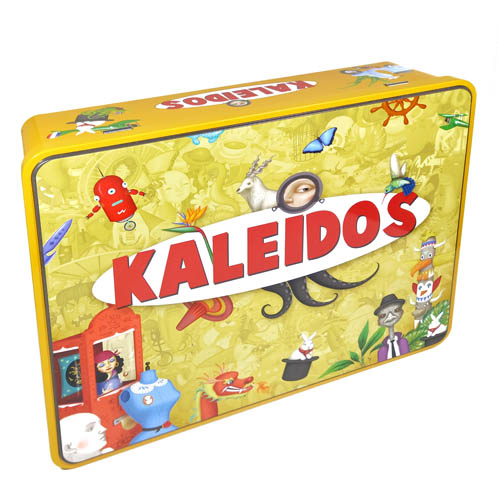
Rules
From 3 to 6 Solo Robbers
In the city, the young Robert was famous for his solo heists. In the criminal world, he was known as Robby Solo… Soon, many began to emulate him, but few came close to his skill.
7 Bank cards, each depicting a bank distinguished by a different color on both the front and back.
42 Heist cards, depicting one of the 7 banks but with the game title on the back.
61 Loot cards.
Complete the most heists and accumulate the highest loot!

Take the seven Bank cards and, depending on the number of players, place from 4 to 7 in a row in the center of the table:
3 players = 4 banks
4 players = 5 banks
5 players = 6 banks
6 players = 7 banks

Distribute the Heist cards so that each player has as many cards as there are banks in play, making sure that the colors match those of the banks on the table. At the end, each player should have a hand of cards whose colors correspond to those of the banks on the table.
Thoroughly shuffle the Loot cards, randomly determine who will start the game, and give the deck to this player who will be known as the Gentleman or the Lady.
The game is played in a series of rounds.
At the start of each round, the Gentleman (or Lady) must place a Loot card face up next to each Bank card on the table, as illustrated in the example.

These cards show amounts of money (from $1,000 to $9,000) or items (whose value is not indicated). The Loot cards indicate how much can be earned from robbing each individual bank. The value of the items will be determined at the end of the game.
Once the distribution of Loot is complete, each player must secretly decide which bank they intend to rob by placing one of their Heist cards face down in front of them.

The Gentleman (or Lady) must also choose which bank to rob by placing a card face down on the table, but only after all others have placed their card. At this point, before each reveals their choice, the Gentleman (or Lady) must make a public declaration choosing between these two options:
1. Indicate the bank they intend to rob.
2. Indicate a bank they will not rob.
After this declaration, all other players have the opportunity to confirm their choice or take back their card and play another (with the possibility of bluffing and putting the same one back…).
The Gentleman (or Lady) must allow a reasonable time for others to decide whether to confirm or change their decision. When they believe everyone is sure of their choice, all the Heist cards on the table are turned over, revealing the bank each player intends to rob.
A heist is successful unless two or more players attempt to rob the same bank. If this happens, the Loot in that bank remains in place.
All those who have robbed a bank alone take the entire Loot contained in it.
Each player places the Loot cards they have acquired during the game in front of them, face up, forming a stack (so that only the value of the top card is visible).
The Heist cards played in the just-concluded round are taken back into each player’s hand.
The Loot deck passes clockwise. Whoever receives it becomes the new Gentleman (or Lady) and another round of the game proceeds.
Each round, the Gentleman (or Lady) must replenish all the banks on the table with a new Loot card face up that can be added to those already left previously. The Loot that can be won in each round is thus composed of all the cards associated with each individual bank.
The supply must start from one side or the other of the row of banks and continue to the right or to the left depending on the choice made. The Gentleman (or Lady) cannot choose where to place the Loot cards. The cards must be placed so that the value of those already present can be read, allowing everyone to have a clear idea of the total available in each bank.
The game continues in this manner until, at the end of a round, four Loot cards remain in a bank. When this occurs, the four Loot cards are removed from the bank and placed back at the bottom of the deck, so they can come back into play later.
This action also leads to the arrival of the Police, who come to visit the robbers…
The player with the greatest NUMBER of cards (regardless of their value) must return the highest value card, placing it at the bottom of the deck. If there are two or more players tied with the maximum number of cards, each of them must discard one card (always the highest value).
Note that cards depicting items have no value until the end of the game. In the rare case that a player has more cards than others, all depicting items, they must discard one at their choice. However, it is sufficient to have a card valued at $1,000 for that to be the one to be discarded.
WARNING: it is possible that at the end of a round, more than one bank has four remaining Loot cards. In this case, the procedure for the arrival of the Police will be repeated as many times as there are banks with four cards, recounting each time the number of Loot cards in possession of the players.
If at the beginning of a round there are not enough Loot cards to replenish ALL the banks, the game ends immediately and the count of each player’s Loot proceeds.
Cards with a monetary value are simply added together, while cards with items have a variable value based on the number of items stolen by the individual player:
One item = $1,000
Two items = $10,000
Three items = $20,000
Four items = $40,000
Five items = $60,000
Six items = $80,000
Seven items = $100,000
The player with the highest total wins the game.

If there are fewer than 6 players, you can decide to add a “virtual” player named Robby Junior, a young apprentice robber on his first field experience.
The number of banks in play must take into account this additional “player” (for example: if there are four of you and you decide to play with Robby Junior, you must use six banks).
Robby Junior will have his own deck of Heist cards, identical to those of the other players, and will participate in each round randomly.
The Heist card played by Robby Junior is the first from his deck and, after playing it, will be placed at the bottom of the deck without ever shuffling it. Try to memorize the moves of the willing but inexperienced robber well, because he will always repeat them in the same sequence…

A game by Spartaco Albertarelli










